
®
CIT Restructuring Plan
Management Presentation
October 2009
Exhibit 99.1

Important Notices
This presentation contains forward-looking statements within the meaning of applicable federal securities laws that are based upon
our current expectations and assumptions concerning future events, which are subject to a number of risks and uncertainties that
could cause actual results to differ materially from those anticipated. The words “expect,” “anticipate,” “estimate,” “forecast,”
“initiative,” “objective,” “plan,” “goal,” “project,” “outlook,” “priorities,” “target,” “intend,” “evaluate,” “pursue,” “commence,” “seek,”
“may,” “would,” “could,” “should,” “believe,” “potential,” “continue,” or the negative of any of those words or similar expressions is
intended to identify forward-looking statements. All statements contained in this presentation, other than statements of historical fact,
including without limitation, statements about our plans, strategies, prospects and expectations regarding future events and our
financial performance, are forward-looking statements that involve certain risks and uncertainties. While these statements represent
our current judgment on what the future may hold, and we believe these judgments are reasonable, these statements are not
guarantees of any events or financial results, and our actual results may differ materially. Important factors that could cause our
actual results to be materially different from our expectations include, among others, the risk that if the exchange offers are not
consummated, the Company may need to seek protection under the US Bankruptcy Code. Even if the exchange offers are
consummated, the risk that the Company’s liquidity is not adequate due to material negative changes to the Company’s liquidity from
draw down of loans by customers, the risk that the Company is unsuccessful in its efforts to effectuate a comprehensive restructuring
of its liabilities, in which case the Company may be forced to seek bankruptcy relief. Accordingly, you should not place undue
reliance on the forward-looking statements contained in this presentation. These forward-looking statements speak only as of the
date on which the statements were made. CIT undertakes no obligation to update publicly or otherwise revise any forward-looking
statements, except where expressly required by law.
This presentation is derived from CIT’s publicly available information and is to be used solely as part of CIT management’s
continuing investor communications program. This presentation shall not constitute an offer or solicitation in connection
with any securities.
Please refer to the amended offering memorandum, disclosure statement and solicitation of acceptances of a prepackaged
plan of reorganization filed on Form 8-K on October 19, 2009 for full and complete disclosures.

Overview & Key Considerations
Restructuring Strategy Overview
Amendments and Revised Terms
Summary of the Offering
Value of CIT Franchise / Business Post Restructuring
Benefits of the Restructuring Plan

Restructuring Strategy
CIT’s commercial franchises provide financing, leasing and advisory services to small and mid-market businesses, a
critical and underserved part of the US economy
The Company continues to develop and execute its business restructuring strategy with the following objectives:
Create Financial Strength
Target capital ratios well in excess of regulatory standards
Enhance liquidity profile
Position the Company for return to profitability and investment grade ratings
Restructure Business Model
Optimize portfolio of businesses
Seek regulatory approval to transfer operating platforms into CIT Bank
Diversify funding model centered on CIT Bank
Multi phased approach to business restructuring strategy
Phase 1: (Complete) Address Immediate Liquidity Challenges – $3B Senior Credit Facility
Phase 2: Enhance Liquidity and Capital - Restructuring Plan (Exchange or Prepackaged Plan)
Phase 3: Optimize Business Model – identify core businesses and align the funding model
In absence of bank-centric model, orderly liquidation will likely be pursued.

Enhance Liquidity and Capital: Phase 2
Plan contains an exchange offer and a solicitation of acceptances of a prepackaged plan of reorganization
Supported by management, the board, the Company’s advisors and the Steering Committee of bondholders
Designed to provide certainty of terms and speed of execution to ensure CIT remains a “going concern” :
Protects against the loss of significant value in a free-fall bankruptcy filing
Preserves the possibility of a successful out-of-court solution
Regardless of path, CIT has designed an approach that can reposition the Company for future success:
Minimizes business and customer disruption during the restructuring
Creates an extended liquidity runway with a strong capital base
Continues to protect the safety and soundness of CIT Bank
Positions the Company for a sustainable, profitable, business model
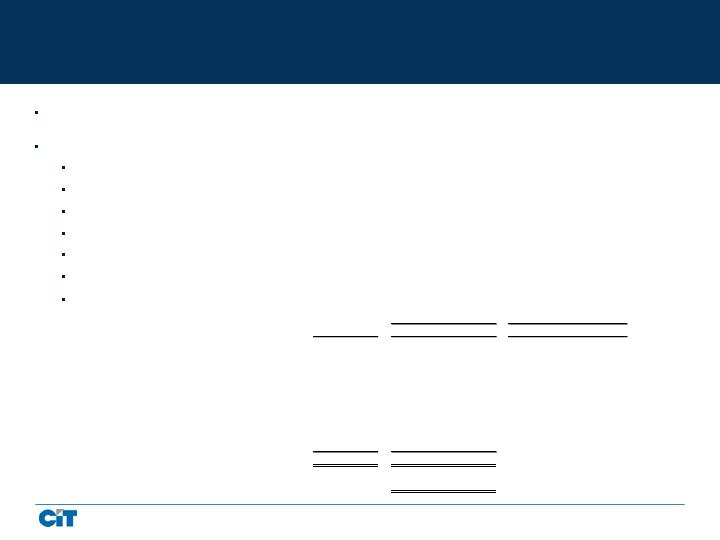
Risks of An Unsuccessful Exchange or Plan of Reorganization
Without an approved restructuring plan, the Company will likely file for bankruptcy without the benefit of a plan of
reorganization and stakeholders will lose significant value.
Impacts include:
Substantial damage to the franchise
Inability to insulate valuable operating businesses from the proceedings
Increased risk of seizure of CIT Bank
Uncertainty and constraints with respect to liquidity
Significant bankruptcy related expenses
Lengthy process in court
Estimated recovery value for general unsecured claims in a accelerated liquidation is between 6 - 37 cents per
$1.00
Claim
Low
High
Low
High
General Unsecured Claims:
Canadian Senior Unsecured Note Guarantee
2,188
$
128
$
815
$
5.9%
37.2%
Long-Dated Senior Unsecured Note Claims
1,189
70
443
5.9%
37.2%
Senior Unsecured Note Claims
25,869
1,518
9,634
5.9%
37.2%
Senior Unsecured Term Loan Claims
321
19
119
5.9%
37.2%
Senior Unsecured Credit Agreement Claims
3,101
182
1,155
5.9%
37.2%
Deficiency Payments on Make Whole
250
15
93
5.9%
37.2%
Other Unsecured Liabilities
954
56
355
5.9%
37.2%
Accrued Liabilities & Accounts Payable
1,052
62
392
5.9%
37.2%
Total
34,924
$
2,050
$
13,006
$
5.9%
37.2%
-
$
-
$
Recovery
Percentage Recovery
Proceeds Available for Distribution to
Subordinated Unsecured Claims
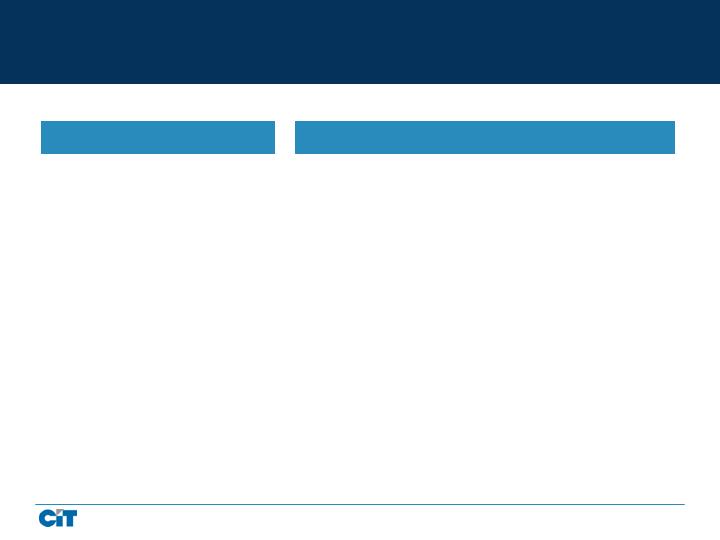
Summary of Offering:
Amendments to Exchange Offer and Plan of Reorganization
Item
Amendment
Senior Notes due beyond 2018
Commenced offer to exchange and solicitation of acceptances
Shortened Maturities
Shortened maturity by 6 months (from November to May) for new
Series A and B Notes
Cash Sweep
Implemented a cash sweep mechanism to assure prompt repayment
of debt with excess cash
Delaware Funding Notes (Series B)
Increased coupon on $2.2bn of Series B Notes offered to Delaware
Funding Notes from 7% to 9%
Subordinated Notes
Increased consideration from 4% to 7.5% equity stake
Preferred Stocks (Series A, B, C)
Receive contingent value rights under plan of reorganization
Preferred Stock (Series D –TARP)
Receive contingent value rights under plan of reorganization and
greater equity consideration in the recapitalization post-exchange
Governance
Provisions regarding Board of Directors

Governance Changes
The Board of Directors will change in several ways as the Company restructures:
A search for new Directors is currently underway to increase the size of the Board from 10 to 13
Upon consummation of the Exchange Offers or Plan of Reorganization, the Board of Directors will include 5
Directors that were recommended by the Steering Committee
At the 2010 Annual Meeting, the slate of directors to be nominated will not include more than 5 of the currently
serving directors
Other governance matters agreed to in the Plan of Reorganization:
No implementation of a stockholders’ rights plan* during the Chapter 11 proceedings;
No staggered or classified board during the Chapter 11 proceedings; and
Provisions regarding special meetings of shareholders to vote for the election of directors
* Except for plans intended to preserve the tax benefits of net operating losses

Cash Sweep Mechanism
Significantly enhances repayment of debt with excess cash
Monthly deposit of available cash collections, net of operating and overhead expenses and secured debt service, from
business proceeds in:
Transportation Finance;
Consumer Finance (Student Loans);
Corporate Finance (exc. Small Business Lending); and
If platforms are transferred to CIT Bank, assets remaining outside the bank for Trade Finance, U.S. Vendor
Finance and Small Business Lending.
Quarterly prepayment of outstanding first and second lien bank debt and notes, by priority, with swept and other free
cash subject to:
12 months of Time-to-Fund (TTF) Requirements, including payments in respect of debt obligations, contractual
commitments (e.g., railcar and aircraft deliveries), and up to 50% of obligations under committed and undrawn lines
in respect of transactions in which CIT is a lead agent
Required CIT Bank investments and additional investments in CIT Bank no greater than $400mm annually
Select reinvestments in Corporate Finance and Transportation Finance no greater than $500mm annually
Up to $500 million of other cash
In addition, reasonable efforts will be made to apply additional swept cash in excess of $2 billion towards further
prepayments
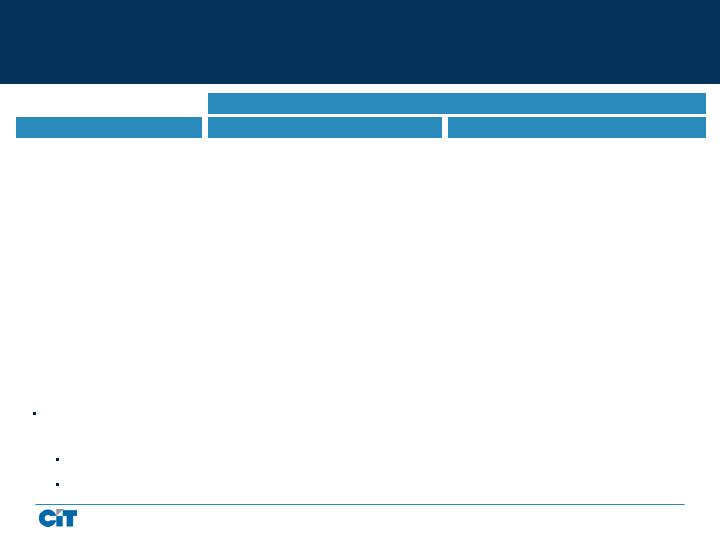
Comparison of Terms
The Company is proposing to lenders of debt not included above an out-of-court restructuring on economically equivalent
terms with the New Notes. Other debt includes:
Bank Credit Lines $3.1B
Other Private Debt $1.2B
Security
The Offers
Treatment Under
The Plan of Reorganization
Senior Debt Maturing 2009
90 cents of New Notes, plus New Preferred Stock
70 cents of New Notes, plus New Common Interests
Senior Debt Maturing 2010 (1)
Senior Debt Maturing 2011 - 2012
Senior Debt Maturing 2013 or Later
Structurally Senior Debt (2)
Subordinated Debt
Junior Subordinated Debt
Preferred Stock, Series A, B, C and D
Common Stock
85 cents of New Notes, plus New Preferred Stock
80 cents of New Notes, plus New Preferred Stock
70 cents of New Notes, plus New Preferred Stock
100 cents of New Notes
New Preferred Stock
New Preferred Stock
Not Solicited
Not Solicited
70 cents of New Notes, plus New Common Interests
70 cents of New Notes, plus New Common Interests
70 cents of New Notes, plus New Common Interests
100 cents of New Notes
New Common Interests plus, Contingent Value Rights
New Common Interests plus, Contingent Value Rights
Contingent Value Rights
No Recovery
(1) Includes 5.38% Notes due June 15, 2017, which notes have a put right on June 15, 2010
(2) Includes Delaware Funding notes and does not include certain other structurally senior debt such as CIT Group (Australia) Limited notes
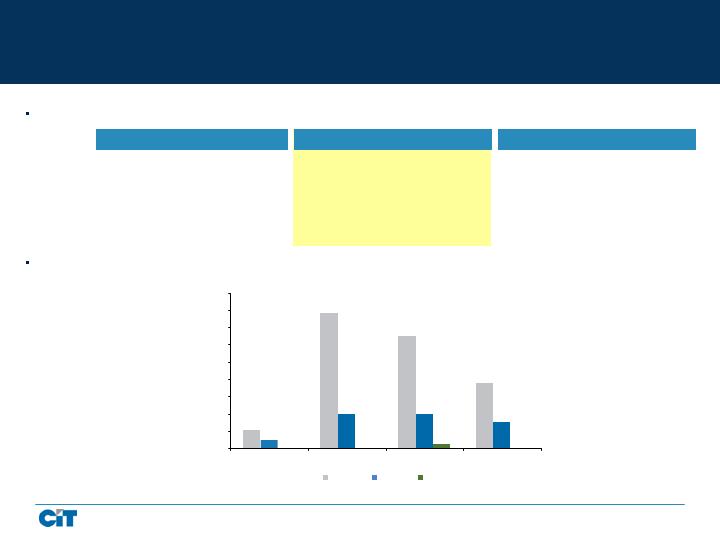
Liquidity Impact
A condition for consummating the offers is that remaining unsecured debt maturities can be no greater than:
Significant reduction in near term maturities
If Restructuring Plan is consummated, projected unrestricted cash at BHC does not drop below $1 billion
2009
2009 - 2010
2009 - 2011
2009 - 2012
Current Cumulative Maturities
$ 1,415 Million
$ 9,698 Million
$16,321 Million
$20,146 Million
Maximum Cumulative Maturities
$ 500 Million
$2,500 Million
$4,500 Million
$6,000 Million
Reduction Required
65%
74%
72%
70%
Maturity Comparison (Excluding First Lien)
$1,046
$7,831
$6,514
$3,751
$500
$2,000
$2,000
$1,500
$0
$0
$242
$0
$0
$1,000
$2,000
$3,000
$4,000
$5,000
$6,000
$7,000
$8,000
$9,000
2009 (Nov-Dec)
2010
2011
2012
Status Quo
Exch Offer
Pre-Pack

Capital Structure Comparison
1.
Does not include the addition of the $3 billion Senior Credit Facility or other post 6/30/09 debt related transactions
2.
Assumes full participation. Does not include impact of TDR accounting or subsequent recapitalization
3.
Assumes ‘Fresh Start Reporting’
Actual
As Adjusted for
As Adjusted for
Exchange
(1)(2)
Pre-pack Plan
(1)(3)
Bank credit facilities
$3,100.0
$-
$-
Secured borrowings
17,635.3
17,635.3
15,601.3
Senior unsecured notes-variable
7,451.7
1,159.0
1,159.0
Senior unsecured notes-fixed
23,801.7
1,511.3
1,511.3
Junior subordinated notes and convertible equity units
2,098.9
199.9
-
Series A Notes offered in the Offers
-
-
16,017.1
14,947.3
Series B Notes offered in the Offers
-
-
1,908.5
1,946.9
Junior Credit Facilities
-
-
2,281.4
1,916.4
Total Debt
54,087.6
40,712.5
37,082.2
Preferred Stock - Series A thru D
3,146.7
3,146.7
-
Preferred Stock - Series F (liquidation preference of $1,400/ share)
-
-
4,828.0
-
Total Common Stockholders' Equity
2,932.2
11,479.3
8,000.0
Total Stockholders' Equity
6,078.9
19,454.0
8,000.0
Total Capitalization
65,545.2
65,545.2
50,460.9
Common Shares Outstanding
392
392
400
Book Value per Common Share
$7.48
$29.28
$20.00
(in millions, except per share amounts)
As of June 30, 2009
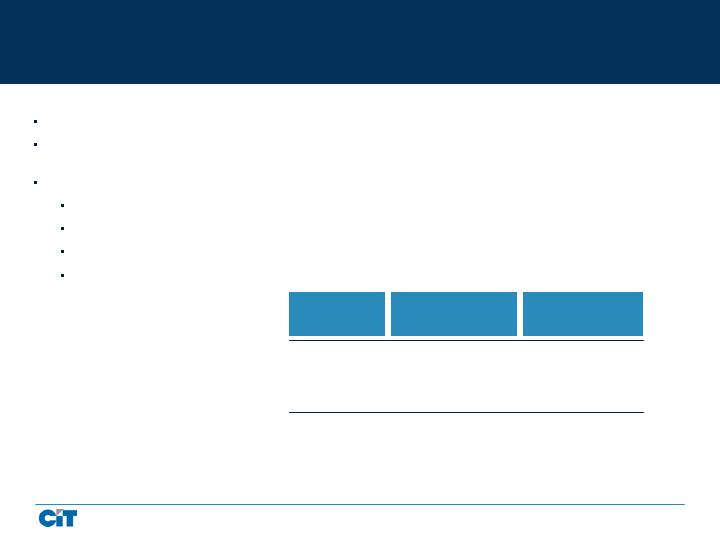
Recapitalization Analysis
If we consummate the offers, we intend to effectuate a recapitalization as soon as practicable
New Preferred stock will convert to common shares aggregating approximately 91% of the Company’s common equity
and voting power
Recapitalization process includes:
Solicit majority approval from shareholders (current common and new preferred vote as one class)
Amend certificate of incorporation to increase authorized common stock
Reclassify preferred stock into approximately 15.3 billion shares of our common stock
Approve reverse split to reduce total shares outstanding
New Preferred Stock
Existing Preferred Stock
Common Stock (Book Value)
Total Equity
at 6/30
$-
3,147
2,932
$6,079
Proposed Offer
(Assumes 100%
Participation)
$4,828
3,147
11,479
$19,454
$-
-
19,454
$19,454
Following
Recapitalization
(Pre-Reverse Split)
392 million
$7.48
Share Count
BV / Share
392 million
$29.28
15.7 billion
$1.24
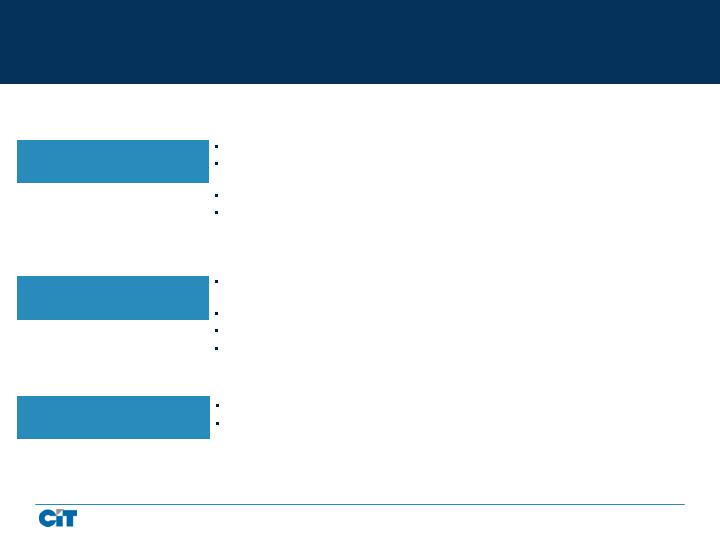
Refinement of Business Model
– Streamlined Business
Optimize Business Model: Phase 3
Strengthen market-leading position as lender to small and middle-market companies
Focus on businesses consistent with a bank-centric model – pursue potential strategic
options for non-core business lines
Shrink balance sheet to improve liquidity and capital profile
Maintain conservative volumes as transition to new model is completed – return to growth
in core businesses as Company and economy recovers
Obtain regulatory approvals to transition Small Business Lending, Trade Finance and
Vendor Finance platforms to CIT Bank
Capture commercial deposits from Corporate Finance and Trade Finance customers
Build commercial and retail deposits through potential strategic transactions
Pursue rating at CIT Bank to enhance access to Capital Markets
Actively manage direct expenses at business segments
Decrease corporate overhead
Bank-Centric Funding Model –
Competitive Cost of Funds
Efficiency Enhancements –
Lower Operating Expense
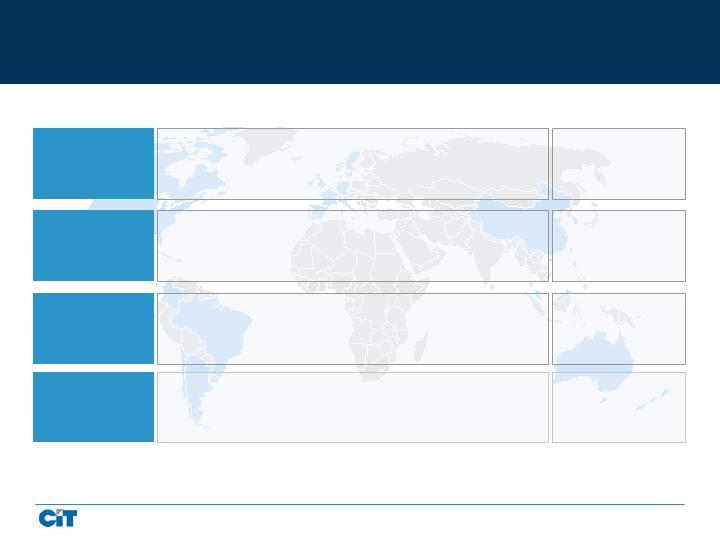
Market Leader in Small and Mid-Market Financing
Trade
Finance
Factoring, lending, receivables management and trade finance to
companies in retail supply chain
Transportation
Finance
Lending, leasing and advisory services to the transportation industry,
principally aerospace and rail
Vendor
Finance
Financing and leasing solutions to manufacturers and distributors
around the globe. Operations in Americas, Europe, Asia and South
Pacific
Mgd. Assets: $5B
Market Rank: #1
Mgd. Assets: $15B
Market Rank: #3
Mgd. Assets: $13B
Market Rank: Top 3*
Managed Assets data as of 6/30/2009
Market ranks as of 2008
* Represents ranking for US Office Products/Tech market; exact global ranking data unavailable
Corporate
Finance
Lending, leasing and other financial and advisory services to middle
market companies (including SBA business), with a focus on specific
industries (e.g., Healthcare, Communications, Media, Entertainment,
Energy, Retail)
Mgd. Assets: $19B
Market Rank: N/A
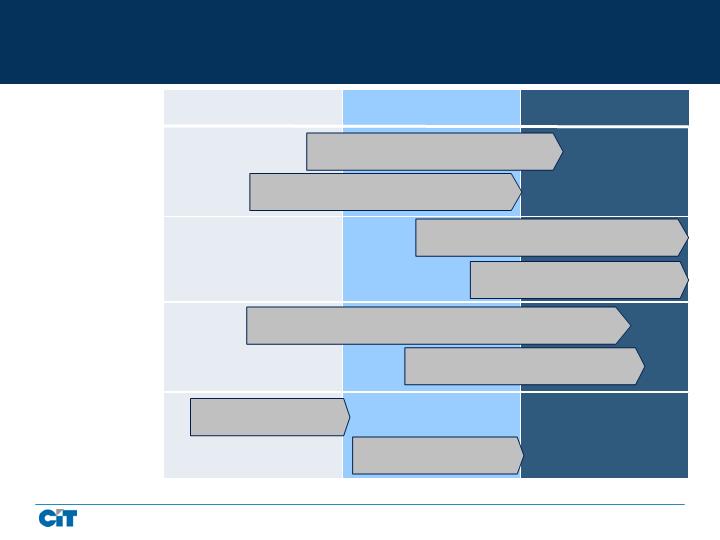
Serving a Wide Spectrum of Commercial Customers
Trade
Finance
Transportation
Finance
Vendor
Finance
End Users
Vendor Partners
Corporate
Finance
Retailers
Manufacturers & Importers
Air
(Commercial & Regional Airlines)
Rail
(Class 1, Regional, Short Rail Lines & Manufacturers)
Small Business
Mid Market
Large Enterprise
Small Business
Traditional Mid-Market
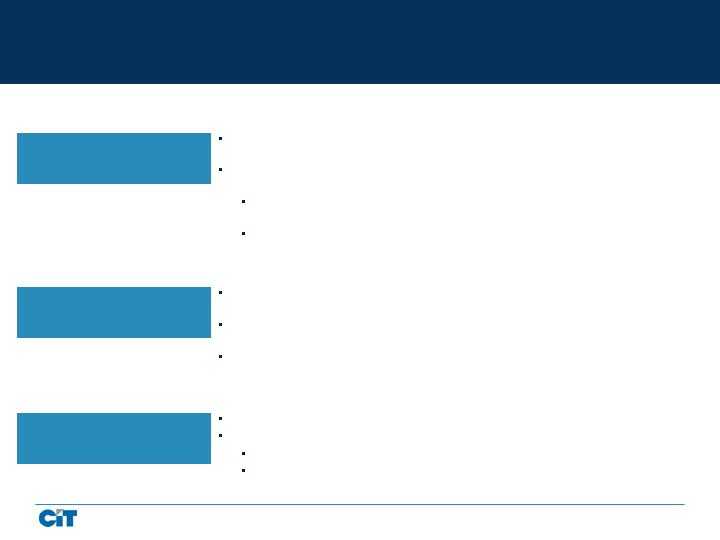
Trade Finance: Strategy Overview
Continued to fund customers in Trade Finance given the strength of this franchise and
commitment to customers
Experienced a decline in factoring volume due to managed reductions, a weak
economic environment, and CIT’s weakened credit ratings
Some non-borrowing customers (i.e., those who only rely on CIT for factoring
receivables only) have been less willing to stay
Some customers left but returned after realizing the servicing difference between
CIT and competitors
Dedicate a significant portion of CIT’s liquidity to Trade Finance – $1B announced in
July as dedicated funds for Trade Finance
Enter into modified (e.g., deferred purchase) agreements with non-borrowing
customers to mitigate their risk
Transition platform to CIT Bank to leverage improved funding costs and potentially
stronger credit ratings at the Bank (regulatory approval required)
Lever stronger funding and credit profile at CIT Bank to actively grow the business
Expand platform through organic growth as well as potential acquisitions
CIT has best-in-class platform which can be easily scaled
Some sub-scale players likely to exit market
Impact of Liquidity Crisis (2009)
Medium- to Long-Term Growth
Strategy
Near-Term Strategy to Preserve
Franchise
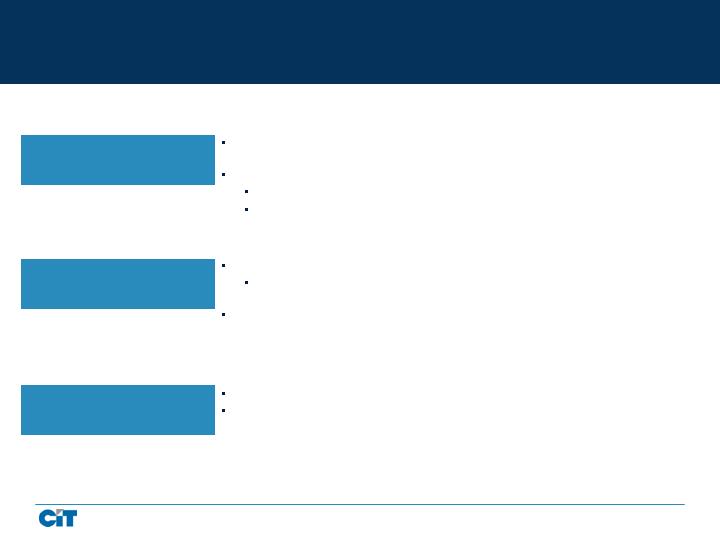
Impact of Liquidity Crisis (2009)
Medium- to Long-Term Growth
Strategy
Transportation Finance: Strategy Overview
Rail and Air markets have weakened due to macroeconomic conditions – Rail has
been impacted to a greater degree due to slow down in US economy
Leasing assets has become more challenging:
Impact on the air business has been limited
Lessees in Rail require a much higher level of ‘customer management’
Near-Term Strategy to Preserve
Franchise
Fund legal commitments of the business (e.g., deliveries for aircraft and railcars)
Strong order book and relatively young fleets allow CIT to pursue this course
through 2010 without weakening the franchise
Focus on credit and operations to ensure continued excellence
Businesses unlikely to be transferred to CIT Bank
Strong order book is essential to maintain a young fleet – a key differentiator
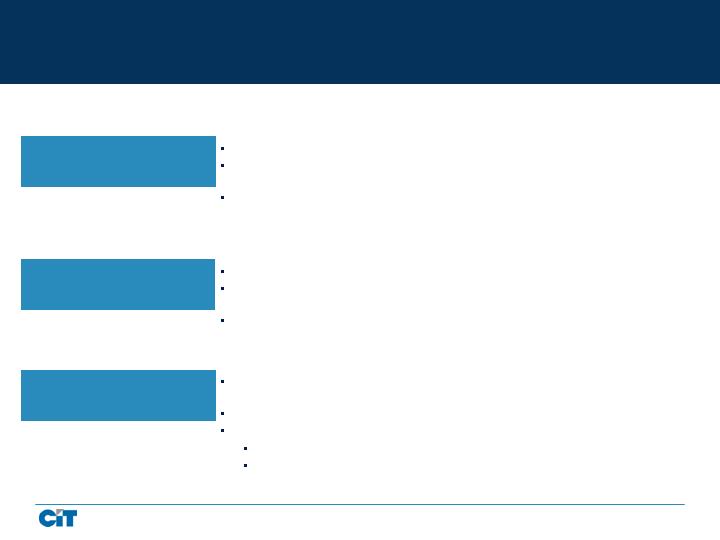
Vendor Finance: Strategy Overview
Continued to fund new volume to preserve vital franchise
Most large vendors have been supportive of CIT through the liquidity crisis and
monitor the situation closely
Microsoft and Snap-On terminated their vendor agreements with CIT due to loss of
investment grade ratings
Focus on core vendor partners
Rationalize geographies to eliminate marginally profitable countries that are not
critical for core partners – Decrease non-US volume
Transfer US Vendor platform to CIT Bank (regulatory approval required)
Utilize CIT Bank funding to actively grow US Vendor business – one of the best
operational platforms in the US
Capture market share from competitors who do not view this as a core business
Maintain a strategic global presence as key selling point. Focus on:
Large developed economies with significant sales for vendor partners
Strengthen platforms in select developing markets (e.g., China)
Impact of Liquidity Crisis (2009)
Medium- to Long-Term Growth
Strategy
Near-Term Strategy to Preserve
Franchise

Corporate Finance: Strategy Overview
Market for middle market leveraged financing has been extremely weak for several
quarters limiting potential new business
Volumes have been minimized to preserve liquidity:
Non-Bank volume has been eliminated (other than legal commitments)
CIT Bank volume has been minimal since July to preserve cash
Focus on retaining top talent through the downturn – sales and credit professionals
are key to franchise preservation
Resize front-end (sales force) given new market realities
Restructure business model to further strengthen credit culture, ensure alignment of
incentives across sales and credit, and reduce expenses
Complete transition to a primarily direct calling organization (vs. past practice of
originating majority of the volume through sponsors and intermediaries)
Prioritize volume for SBL business and industry sub-segments that have been
traditional strengths for CIT: Healthcare, Retail, Communications, Media,
Entertainment, Energy
Continue to develop fee-based advisory capabilities – which will become more
important as the origination effort shifts to direct calling
Impact of Liquidity Crisis (2009)
Medium- to Long-Term Growth
Strategy
Near-Term Strategy to Preserve
Franchise

Post-Restructuring Financial Trends
Volumes remain conservative in 2010 given macroeconomic conditions and bank transition
Measured growth in core businesses post-2010
New Business Volume
Assets will decline over the next few years due to conservative volume and streamlining of
business segments
Asset Growth
Continued pressure through 2010 due to high cost financing required during restructuring
process
NIM to improve post 2010:
Excess cash used to pay down most expensive secured (first lien) debt
Utilization rates improve in the Rail business
Net Interest Margin
Improvement in 2010 due to increase in factoring commissions and ability to syndicate loans
for gains (as economy recovers)
Non-Spread Revenue
Improvement in 2010 as direct business expenses and corporate overhead are re-sized to
align with smaller CIT
Operating Expenses
Provisions decrease as credit metrics improve
Credit Provisions

Benefits of Restructuring Plan
Recognizes value in commercial franchise – market-leading positions built over a century
Exchange Offers or Plan of Reorganization provides:
Speed and certainty to ensure CIT remains a “going concern”
Significant liquidity extension
Robust capital generation
Clear roadmap to profitability
Amended terms improve economics and governance
Restructuring strategy endorsed by bondholders and reviewed by regulators
Submit ballots to your nominees on or before October 29th





















